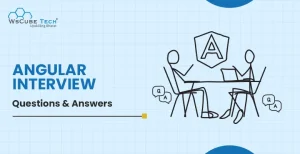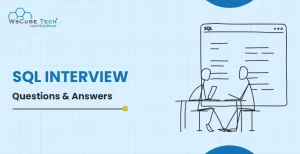Website design and website development are two concepts that have been around ever since the introduction of websites. Although these are the two key aspects of website creation and are often used interchangeably, they share a few nuanced differences, making them vastly unique concepts from each other.
Earlier, the difference between website design and development was quite basic. The former deals with the creative aspect, while the latter is more technical and involves code. However, with advancements in the technical industry and these two sectors, the two now share fine distinctions. Today, apart from designing, web designers are also well-versed in HTML and CSS. Moreover, it’s not difficult to find web developers who can create exceptional website layouts and designs.
However, as we dive deeper, we will find that the two concepts are clearly different and play completely distinct roles in building websites and web applications.
In this blog, we will take a closer look at web design vs web development and how they complete the website creation process.
What is Web Design?
Website design involves everything dealing with the visual aesthetics and usability of a website, including information flow, color scheme, layout, and other factors related to the UI/UX. Web designers put different aspects and parts together to create an attractive online space for a business.
Rather than building websites, web designers use Illustrator and Photoshop to create a prototype of the home page and internal pages. This gives clients an idea of where their website design is going while working as a building block for developers when they write code.
A website usually stands out for its user experience. If it offers a responsive design with pleasing features and is easy to navigate, it can score high points among internet users.
Therefore, web designers take care of two primary things- layout and color scheme- with the goal of creating a digestible and appealing site. They design formats, storyboards, color palettes, logos, UI, CTA buttons, typography, branding, UX, etc.

What is Web Development?
Web development centers on the mechanism that enables a website to work seamlessly. Web developers write the code to make a website tick and bring a web designer’s idea to life through a functional website. They determine how a website will work and function by creating basic and advanced features.
Moreover, they are responsible for the frontend or backend side of a site or web app. Front-end development concentrates on writing code to decide how a website is displayed across all devices and browsers. The back-end development is the server side of a website that manages data within the database and displays that data on the front end of the website.
In simple terms, web developers make a web design function as it is expected. For example, a designer creates call-to-action (CTA) buttons, but developers write the code to ensure that when users click on that button, it responds correctly.
The same is true for different elements on a website, starting from a contact form to hyperlinks to a navigation bar. If you want to be a part of this lucrative profession, take up our web development course now and acquire skills that will make you career-ready.
Here are some common tools and skills that web developers must master:
- HTML/CSS/JavaScript
- Frameworks (AngularJS, ReactJS, Ember)
- CSS preprocessors (LESS or Sass)
- Libraries (jQuery)
- Web template design
- Git and GitHub
- On-page search engine optimization (SEO)
Also read: How to Become Web Developer in 2025? Beginners Guide
Web Design Fundamentals
As we discuss web design vs development, it’s essential that we gain a fair knowledge of the best practices of visual design. Here are a few web design fundamentals to follow while designing websites.
Color Theme and Psychology- Designers use different hues and color schemes strategically to spark emotions and convey a brand’s vision.
Layout- It is the responsibility of a designer to create a layout that makes it easier for visitors to read the content of the page.
Text- Clearly arranged and well-formatted texts increase the visual appeal of a website and ensure effective communication.
Contrast- Contrast highlights important elements of a web page and maintains legibility.
Hierarchy- It shows the importance of various elements of a website.
Explore More Blog Topics
| Is Web Development a Good Career? | Java vs JavaScript |
| Magento Vs WooCommerce | HTML Vs HTML5 |
| Frontend Vs Bakend Development | Coding Vs Programming |
Web Design Specializations
Apart from fundamentals, web designers also need to know best practices to offer a seamless user experience and user interface. They make a website look good and contribute to its appeal and usability. Hence, they must focus on the overall feel, look, and style of a website using different tools, technologies, and software, such as Corel Draw, Photoshop, etc. Here are web design specializations you should know:
1. User Experience (UX) Designers
UX designers figure out how to get users’ attention at once, engage them, compel them to take design actions, and make them come back. They take care of how users would feel after using the website. This means they focus on the efficiency and usability of a website.
Their designs are mostly research-intensive and even demand interviews with the target audiences. Their other responsibilities include wireframing, A/B testing, and prototyping. Moreover, they build user stories, sketch user personas, and run tests to ensure that a website meets user requirements, has a logical web flow, and exhibits intuitive interactions.
2. User Interface (UI) Designers
UI designers build the structural foundation of a website based on the UX process to create appealing websites. They create illustrations, graphics, typography, and images to improve the layout and display of websites across various devices. Basically, they focus on aesthetics, interactivity, and neatness and make it easier for users to navigate through the website.
Also, they maintain visual consistency to avoid any confusion and engage the visitors. User interface elements include navigational components (slider, search fields, tags, and icons), input controls (menus, buttons, drop-down, and data fields), and informational elements notifications, progress bars, and message boxes).
3. Visual Designers
Visual designers combine UX and UI to design dynamic, efficient, and appealing websites and other interfaces. They make sure that the digital product looks attractive. Many confuse graphic design and visual design. The former revolves around print and digital design media, while the latter is about web and app interface designs.
Web Development Fundamentals
To understand web development or web design, which is better, it is important to get familiar with the fundamentals of both. Once a web designer decides the look and feel of a website, it’s time for a web developer to turn this design into a fully functional and live website. For this, they need to understand the principles of web development clearly.
Structure and Hierarchy of a Website- Web developers use HTML to create the structure and hierarchy for web pages.
Hosting and File Transfer Protocol (FTP)- After building a website, developers launch it and push it live. However, the process may vary based on where a website was developed- the local server or hosting account of the client.
Responsive Website- The website must be compatible with all devices and work efficiently across all screen sizes, operating systems, and browsers.
Security- The website must be secure and protected from any infringements and cyberhacks.
GitHub, Git, and Command Line- Developers use these open-source platforms to manage version control.
Also read: Types of Web Development in 2025: Full Guide
Web Development Specializations
Web developers are coders or programmers who convert web designs into rich and accessible websites. As a website has different aspects- frontend or backend, developers can specialize in any one of them based on their skill sets.
They use different tools and languages, such as jQuery, PHP, HTML, CSS, JavaScript, Python, React, etc., to build a seamless website. They collaborate with designers to build web pages according to their designs. To understand web development and web designing difference, you must know web developer specializations.
1. Front-end Developers
Front-end development involves crafting the part of a website that users interact with or see. It is also known as the client side of a website or web app and involves building user-facing or visible elements that decide user experiences, such as text colors, fonts, images, buttons, navigation menu, graphs, tables, etc.
Whenever you open an app or website, everything you see on your screen is implemented by front-end developers. They aim to make a website responsive and performance-oriented. The primary languages used for front-end development are HTML, CSS, and JavaScript.
2. Back-end Developers
Back-end development focuses on building the core structure of a website, which is the server side. This is behind-the-scene of a website where all the coding and programming take place. It stores and arranges data, making sure that everything on this end is working well. Users can’t see or interact with the backend and indirectly access the elements and features through the front end.
It includes working with system components without user interfaces, writing APIs, scientific programming, or creating libraries. Back-end developers use complex programming languages, such as Ruby, Python, Java, PHP, etc., to integrate servers, databases, and applications.
3. Full-stack Developers
Full-stack development combines the front-end and back-end elements of a website. Hence, it demands developers who are proficient in front-end and back-end technologies and programming languages.
They possess knowledge of user-side application development, Windows and Linux server setup and configuration, website debugging, database operations and querying, server-side API coding, structuring and designing web pages, and more.

Difference Between Website Development and Website Design
| Criteria | Web Designers | Web Developers |
| Meaning | Web design is concerned with how a website looks and feels to users. It involves creating graphical components to be used on the World Wide Web. | Web development is concerned with the functionality of a website, i.e., how it works. It involves creating features and writing codes. |
| Tools and Technologies Used | Web designers use tools such as Adobe Photoshop, Illustrator, Dreamweaver, Sketch, etc. | Web developers use programming languages such as HTML, PHP, JavaScript, CSS, Python, Ruby, jQuery, etc. |
| Area of Expertise | Web Designers are creative and add aesthetic elements, turning ideas into visually appealing designs. | Web Developers are more technical and ensure that the website is user-friendly and meets the client’s specifications. They turn designs into functional websites. |
| Skill Set | Web designers must be proficient in Photoshop, Illustrator, and other designing software. | Web developers must possess HTML, CSS, and JavaScript skills, along with open-source CMS. |
| Job Responsibilities | Web designers are responsible for designing a website’s visual and creative aspects and don’t need to be involved in technicality. They create the idea and style of a website and prepare mockups based on visual, UX, and UI features. | Web developers are technically savvy with knowledge of sophisticated programming languages and frameworks. They determine the financial and technical feasibility and accordingly work on coding. |
| Deadlines & Time Management | Web designers invest their time in building wireframes, choosing the right images, designing the themes, and creating designs specified by the clients. | Web developers spend most of their time on website maintenance, including updating the CMS, providing online support in case of any issue, and monitoring security. |
| Types | User Experience (UX) DesignerUser Interface (UI) DesignerVisual/Graphic Designer | Front-end DeveloperBack-end DeveloperFull-stack Developer |
| Education & Certification | Web designers can have one or more of the following certifications: Web Developer, Master Certified Web Professional - Designer (CWP), and Web Programming Certificate. | Web developers complete the following certification courses: Certified Web Professional - Web Developer, Master Certified Web Professional - Designer (CWP), and Certified Software Development Professional (CSDP). |
| Portfolio | The portfolio of web designers highlights their capabilities in web designing, layouts, themes, graphics, etc. | Web developers exhibit their skills to rearrange and simplify code, so other developers and stakeholders find it elegant and comprehensible. |
| Web Designer vs Web Developer Salary | Web designers are in less demand than web developers, and their average annual salary is relatively lower. | Web development is one of the most sought-after skills, and recruiters are ready to pay handsome salary packages to skilled candidates. |
Web Designing and Web Development- Difference in a Nutshell
Web design and web development focus on two distinct aspects of a website. However, web designers and web developers must collaborate constantly to complete the website creation process efficiently and deliver the project successfully. We can conclude that website design and website development can’t survive without each other.
Does website development sound exciting to you? Then sign up for our online full-stack web developer course and build skills and knowledge required to make a promising career.
Free Courses for You




Leave a comment
Your email address will not be published. Required fields are marked *Comments (0)
No comments yet.